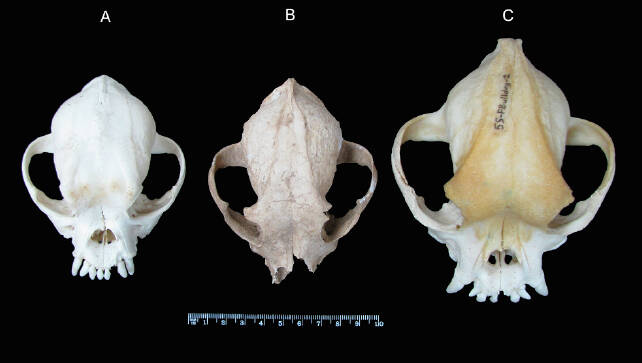Researchers believe that the dog was a beloved pet, treated well in life and honored in death.

Wrocław University of Environmental and Life SciencesThe Tralleis dog skull compared with modern dog skulls.
Dogs have been by humanity’s side since before the dawn of recorded history, but new research suggests that our more-recent fondness for flat-faced dogs is anything but a modern trend. In fact, the breeding of bulldog-like canines can be traced all the way back to ancient Rome.
As reported by Arkeonews, analysis of a 2,000-year-old dog skull with a particularly flat snout revealed that the ancient dog shared striking similarities to a modern French bulldog.
The skull was unearthed at a Roman-era site in the ruins of Tralleis (now Aydın in modern-day Turkey) in 2007, but the remains were in such poor condition that little attention had been paid to them. That changed in 2021, however, when researchers Aleksander Chrószcz and Dominik Poradowski from the Wrocław University of Environmental and Life Sciences and Vedat Onar from Istanbul University took an interest in the skull.
“Fortunately, the skull was not so damaged or fragmented to prevent its measurements,” Chrószcz said, “and this research is an important part of our investigation because taking measurements allows [us] to compare it with other results of archaeozoological research, and with bone material from modern animals.”
The research team conducted craniometry on the specimen — a scientific skull measurement — and compared it to craniometry results from modern dog skulls.
Chrószcz noted that the poor preservation made it impossible to measure the actual length of the skull. Still, researchers were able to take several other measurements, including the area of the skull’s base, the tympanic cavity, the teeth, and the palate.
“In this case, there was no doubt that it was the skull of a brachycephalic (short-nosed) dog,” Chrószcz said, “and a relatively small one.”
The scientists also utilized a radiocarbon dating procedure to ensure that they were indeed dealing with an ancient find. Through this method, they determined that the dog lived more than 2,000 years ago, sometime between 169 B.C.E. and 8 C.E., in the early years of the Roman Empire.
This is also only the second known specimen of a flat-faced dog dating to the Roman age, Science Alert reported, with the first excavated from the ruins of Pompeii.
Despite the small number of flat-faced dog skulls found from the era, researchers say the evidence is enough to indicate that specially bred brachycephalic dog breeds began in the Roman period and became more common later on.

Austin HarveyA photograph of the author’s dog, Bodie, an American pocket bully.
“The Tralleis dog archaeozoological analysis proved that the mentioned specimen was a pet-like dog, resembling small dogs of the French Bulldog type,” they wrote in their study published in the Journal of Archaeological Science. “The emergence of dogs with this typology is also likely to have something to do with the desires and wishes of the Romans in Tralleis.”
Notably, most known dog breeds were developed more recently, with many only dating back to the 18th century. However, the researchers acknowledged that ancient Greeks and Romans, particularly those of noble class, would have also preferred noble dog breeds and paid large sums for them. This likely, as it has in modernity, inspired the breeding of dogs to develop certain traits that would have been desirable.
“[Romans] are deemed to be the first researchers in the scientific world to systematically breed dogs and record the qualities and functions of different breeds,” the researchers wrote. “They were well aware that the selection can affect not only the appearance of a dog, but also its abilities and behaviour.”
This is further evidenced by the wide variation in the skulls of ancient dogs. The skulls of domesticated cattle and pigs, for example, certainly differ from their wild counterparts, but there is little variation among skull types of domestic breeds. Comparatively, the skull types of domesticated dogs vary by a wide margin.
The dog’s burial in the tomb at Tralleis also shows that it was likely a beloved family member, much like dogs today.
“Maybe it was the best friend and companion of the deceased, who probably included in his last will the wish of a common burial,” the researchers wrote. “Someone must have loved this dog.”
After reading about this ancient dog, read about the time paleontologists discovered the remains of a “bulldog-faced” dinosaur in the Sahara Desert. Or, learn all about silphium, the ancient Roman “miracle plant” that was consumed into extinction.





